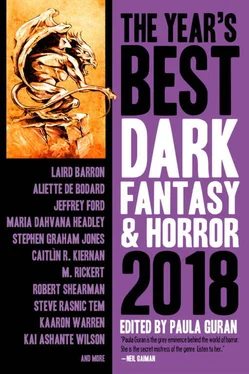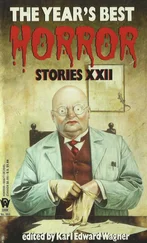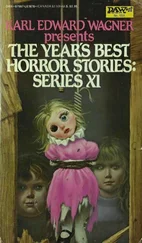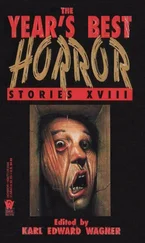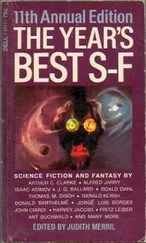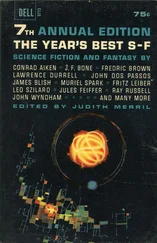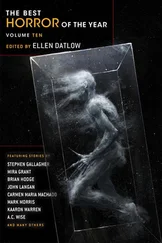As reported by Fate, their sole uniforms were ankle-length black dresses of a sateen weave. Even in summer, out in the forest, hunting the yellow shelf fungus that grows on the sides of trees (they made a good profit drying it, crumbling it up, and curing it with honey to make a kind of sweet brittle), they wore light corsets and high collars. Their long black hair was gathered into one large knot and left to lay upon the spine. To the Halloween celebration they brought a basket of Kane’s Crumbs, as the local treat had come to be known. The sisters, though both handsome women, weren’t asked to dance. They didn’t drink or eat but sat and simply stared at the fire and the goings-on. Their fixed expressions were the only masks they needed.
Sometime after the drunken singing had turned to whispered laughter a small meat cleaver appeared, as if from nowhere, in Gillany’s left hand. Its blade glistened in the glow of the dying fire as it sliced the air, struck, and split the backbone of Ray Walton, the foreman at the glass factory. As he screamed, blood immediately issuing from his mouth, Mavis put a knife through the throat of the Ahearn girl, who folded to the ground like a paper doll. They each went on hacking out their own private trails of horror: fingers flying, blood and bowels falling, eyes skewered, ribs cracked, wrists hacked. A storm of screams broke the stillness of the barrens.
It took some time for a group of factory laborers—male and female—to subdue the sisters. The Kanes fought, it seemed, without awareness—as if they were under a spell. By the time the two murderers were tied up and being led away, there were six dead and twenty wounded. That’s a lot of people to dispatch in a relatively short time with only sharp kitchen utensils. The Burlington County sheriff in Mount Holly was sent for, and the twins were incarcerated in separate store rooms in the glass factory. Old Dr. Boyle, once of Atsion and since run away to the woods after accusations of malpractice, was already on hand, drunk, pronouncing death and treating the wounded. He agreed with Mr. Shaw’s assessment that the attack was too random and mindless to have carried an intention of murder. Most everyone who witnessed it firsthand agreed.
When his duty to those injured at the celebration was finished, Boyle went to the factory to inspect the Kanes. By then the sun was coming up, and the breeze dropped yellow oak leaves in his path. The smoke from the bonfire pervaded the air, bottles lay strewn about the clearing behind the factory and down the path into the deep pines. He entered the brick structure and was greeted by Shaw, who showed him down a back hallway to a small door hidden by shadow. Boyle, a careful man, put his ear to the door and listened. The factory was empty and unusually silent.
“Who can tell the difference, but I think someone who would know said this was Gillany,” said Shaw.
“Is she tied up?” asked Boyle.
“Oh, yes, quite securely.”
“Did she say anything when you got her in here?”
“Nothing. She foamed at the mouth and spit. Growled some.”
“Okay,” said Boyle, and nodded.
Shaw moved forward and inserted a long iron key into the door’s lock. He turned it, there was a vicious squeal from the hinges, and they entered. The room was small, with a low ceiling and one window at eye level looking out across an expanse of reed grass toward the pond. The only light in the dim room came from that source. Boyle felt claustrophobic. He set down his bag, took off his hat and coat, and hung them on the back of a chair. The only sound was that of the woman’s breathing, steady and strong. She was asleep on the floor, her hands bound behind her back, feet tied. Her black hair was unknotted and covered her face. Blood soaked the sleeves and skirt of her dress.
The doctor had Shaw fetch him a lantern, and by that, he examined her. When he rolled her onto her back, he discovered her eyes were wide open as she slept. “Most unusual,” he said, bringing the light closer and closer to them, unable to make the dilated pupils constrict. As he wrote in his personal report of the case (held, along with surviving files of his other cases, at the Joseph Truncer Memorial Library at Batsto Village), “There were a number of odd signs upon the first of the Kane women I examined, not the least of which was a high fever. The eyes were like saucers, the skin around the sites of her lymph nodes had gone a vague green, her eyelashes had fallen out, and there was a silvery substance dribbling from her left ear. All of these struck me as potent signs of disease. When I inspected her lower body, I found her legs covered with insect bites, which I knew were chiggers from that feel of sand when I brushed my open palm against her shins.”
According to the story, it’s then that Shaw, standing by for support along with his wife, who had since joined him and Boyle in the store room, took a small jump backward and gave a grunt, pointing at something white wriggling out from beneath Gillany Kane’s undergarments. Boyle swung the lantern to give a better view. There wasn’t just one bloodless worm inching down her legs, but it was clear there were a dozen or more. Fate Shaw put her hand to her mouth and gagged. The doctor got to his feet and moved away as fast as a man of seventy-five with a bad liver and bad knees could. He went to his bag, hands shaking, and removed his tools to extract a blood sample. As he leaned over the body again, he called over his shoulder for Shaw and his wife to get out. “No one is to enter this room or the one in which the sister is being kept until I return. Make sure to lock them both as soon as I’m gone.”
Back in his home halfway between Cadalbog and Harrisville, Boyle brewed himself a pot of coffee and brought out the brass microscope a wealthy Dutch patient of his had gifted him early in his career for saving a favorite son. Still not having slept from the previous night’s festivities and mayhem, he peered bleary eyed into the tube of the mechanism at a slide holding Gillany’s blood. What he wrote in response to what he witnessed through the eyepiece was only this—“A strange pathogen, blossoming, from the woman’s blood cells—many armed, like the wild witch-hazel flower. I’ve never seen the like.” He stood from his table on which the microscope rested and stumbled to bed. There he slept for a brief interval before heading back to Cadalbog.
He arrived at the factory in late afternoon to find a commotion. It seems that the woman who was hot with fever and in a trance, sleeping with eyes open, somehow revived enough to smash through the small window that looked out upon the cedar pond. As Fate Shaw put it, “We were novices as prison guards. No one ever suspected she’d break out. It was beyond possibility to us. A search party has been sent out after her.”
Boyle told the Shaws and a few of the workers not home grieving for murdered loved ones or caring for those wounded, “Gillany’s got a disease I’ve not ever heard of or seen before. Something that has crawled out of the dark heart of the barrens, no doubt centuries old. She’s got the telltale signs of a bad chigger infestation on her legs. I believe she spends a good deal of time in the woods? She and her sister are mushroom gatherers, if I’m not mistaken.”
Fate Shaw nodded.
“I’m guessing the chiggers carry the bacterium. She’s infected. We’ve got to find her and treat her, or if she’s discovered already dead, burn her.”
“Not to mention, she’s diabolical with a meat cleaver,” said Fate.
“Whatever it is, it’s like typhus, a parasite that affects the brain.”
“What about her sister?” asked Shaw.
“Take me to her,” said the doctor.
The factory owner handed Boyle a rusty Colt revolver. “In case she becomes murderous. It’s loaded.”
Читать дальше
